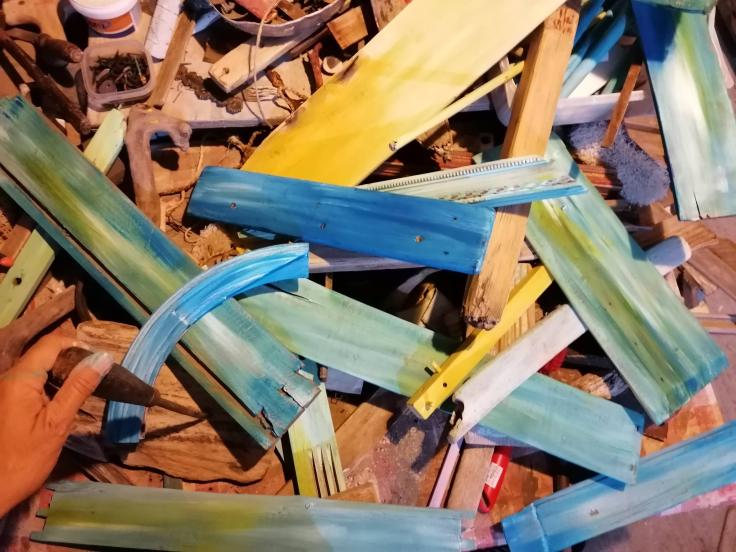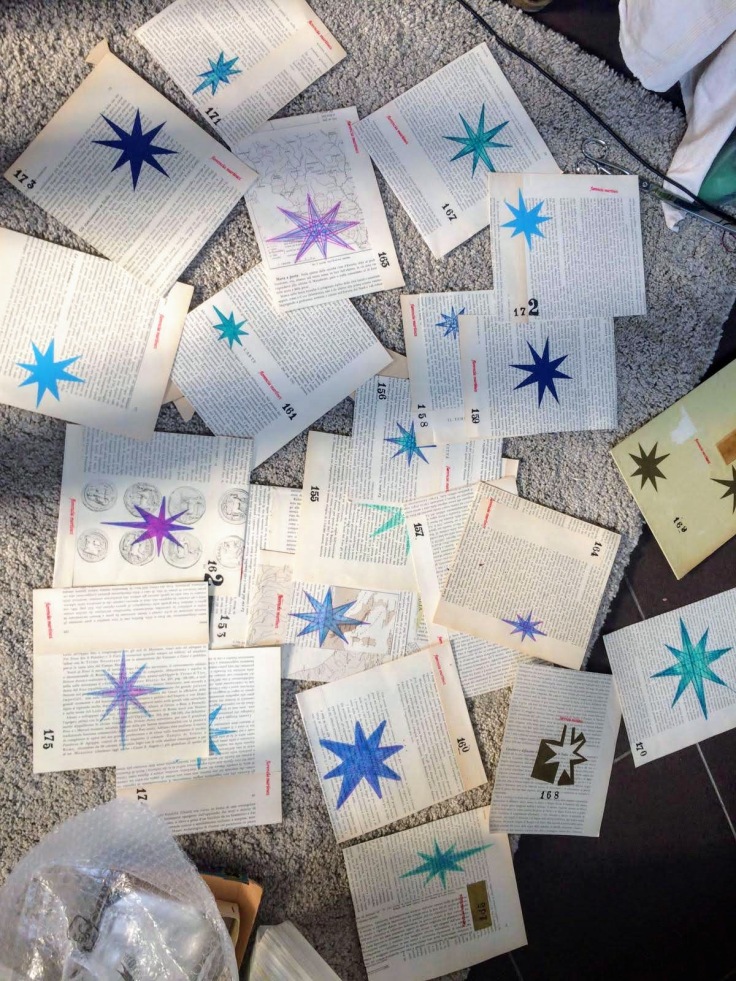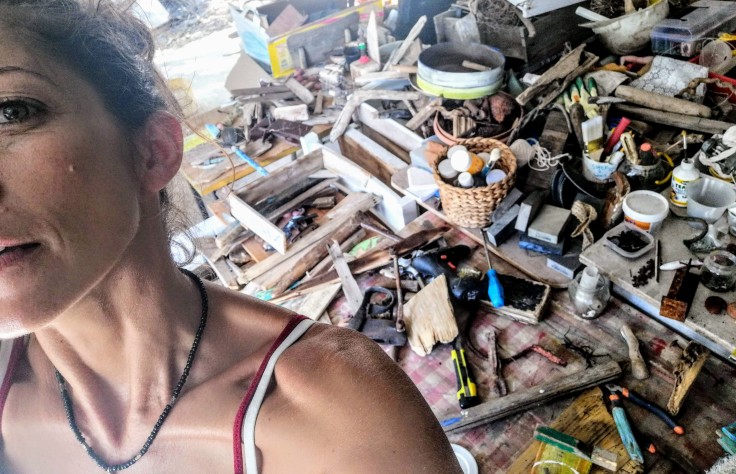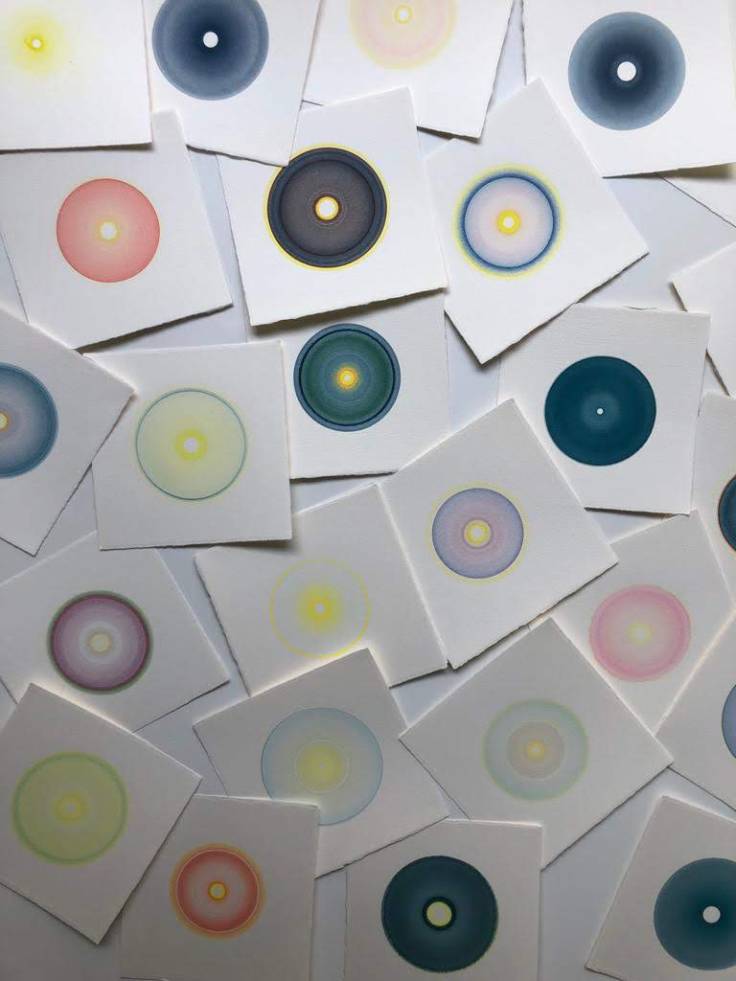Il viaggio, l’origine, il senso.
Florencia Martinez, Evi Tsana, Lorenza Morandotti
di Alessandra Redaelli
When moving in a feminine artistic environment, caution is required. I say this as a woman, aware that this thing – that of being a woman – be it still, today, a noteworthy feature, like a mole (beautiful, for charity) or some mysterious eccentricity. Equality does not exist, because we insist, tirelessly, on being women. Or maybe one day it will exist. But that day still seems far away. The art of women is therefore always seen as something special, to put under the lens. If there are three women, all very powerful in the message and in the language, and maybe they chose to be introduced by a female curator, and to exhibit in the heart of an island (feminine noun) in a country that is the cradle ( accessory so purely feminine … who knows why then) of civilization, the result is likely to be something explosive, something to handle with care. With caution, for the note.
This is not a feminine exhibition. No more feminine than it is, let’s say, a novel like American pastoral, written by one of the most machos authors on the planetary scene (Philip Roth here speaks of family, affections, love and children, right?). But it is an exhibition intrinsically linked to the feminine that moves more deeply under the skin: it is an exhibition that speaks of guidance and hospitality, of loving preservation of the past in search of a meaning, of journeys that lead from the origin to the infinite, starting from the heart – and from the uterus – of our own essence. Talk about everything that matters most. Talk about what gives us the strength to go on every day.

In the heart of a fortress that boasts five centuries of history, on the Acropolis of Rethymno, in Crete, in a labyrinth of thick walls, built in large stones, interspersed with impressive all-round arches, under vaults that bend to welcome the viewer in environments that are at the same time grandiose and intimate, between heavy columns, with a square base, a path made of small objects and lightness unwinds. The past of this place that over the centuries has undergone infinite transformations – it has been a barracks and a military hospital, a warehouse and a seat of public offices, also houses the remains of a mosque – is intertwined with the present of the transformations that our today is experiencing company in the work of Florencia Martinez.

La buena estrella (The good star) is a wish and a hope. Inside a building built to defend itself, voted to close, the Argentine-born artist (and therefore a traveler herself) invents a winding and spiraling path that bodes well for the usual travelers, those of yesterday and especially those of today and of tomorrow. Choosing as a support a series of Italian tour guides from the fascist era, their yellowed sheets, the torn pages at times, the obsolete language, the artist creates a path of eight-pointed stars that forces the viewer to look down, to ignore the walls and obstacles and take on the role of those who hope with all their strength that a good star is leading their path and that that pilgrimage does not end in disaster. The path is interspersed with papier-mâché bowls full of 1 and 5 cents coins and from time to time a tour guide with Argentinian banknotes on the cover. The content of the installation goes beyond the immediate reading, beyond the actuality, of the routes of the migrants that starting today from Africa are desperately looking for a safe haven (even if certainly the thought – and also the heart – goes to nest there). What we try to track down here is rather the sense of travel, of moving, of migration, which should not be seen as a social problem, but as a historical value, a crucial moment in the great changes of the planet, and in this meaning can be a richness, a precious opportunity. While the reference to money is twofold: on the one hand it wants to highlight how every decision, every action, every choice today seems to be influenced by money, on the other – with a reversal of very clear logic – draws our attention to the fact that the masses that they move in search of a place to feel good, of a well-being, also economic, they do not lose legitimacy for this reason, and that their request is fair, dignified and deserves listening.
While those miserable bowls, that little money of almost no value (which we can imagine thrown from a distracted hand in a street of a well-fed metropolis), immediately bring to mind the needy who arrived here and found nothing to await them. Always attentive to issues related to belonging and loneliness, inclusion and exclusion, roots and uprooting, relationships and prevarications, love and love, Florencia Martinez is therefore able to distance herself from her gaze and give of migration a different vision from the stereotype. The feminine spirit here is not that of the mother who opens her arms in the gesture of welcoming and offers a roof and a hot dish. Not only that, at least. It is something more profound and absolute, constituted by the awareness of change, so profoundly and intrinsically feminine. Because the woman opens and looks for third ways, thinks outside the square and sees solutions and openings where the male spirit sees obstacles and closures. Feminine is the awareness of the flow, of changing and letting go, and so is La buena estrella: trust me, follow the path, and let luck be with you. And woman is also the eight-pointed star, not only Stella Polare and guide by antonomasia of wayfarers, but also representation of the goddess Ishtar and in general of female power.

The work of Evi Tsana (Greek, and therefore here in her lands, but long lived in Italy) stands as a deepening and an ideal continuation of the journey undertaken. Hers Ephemeral Island is the landing place and also the coveted treasure. And it is essential to analyze what this treasure is made up of. With the intention of highlighting how precious everything is that has passed and experienced, the artist rethinks the concepts of beauty, useful and useless proceeding with a capillary collection. Woods smoothed by the sea, rusty tools, pieces of old furniture, drawers, fragments of stories and unknown but no less interesting events, are transformed in his hands into the beating hearts of small temples. Here we meet the all-female vocation for the preservation of the past, for the protection of what has been, because the woman has always been the custodian of the family stories, which are handed down and which ensure that piece by piece, everything is knotted together and makes sense . And the rest of this has always been woven by the artist’s work, ever since he recreated the spirit of the small newsstands that are found all over Greece on the side of the road, through the objet trouvé, a reminder of events or loved ones . Her Iconostases were just that: almost ex-votos, but substantiated by an oneiric matter, like when she told Adolescence through bunches of new and rusty keys or when, explaining the uphill path for the realization of a dream, she contained in frame a small scale. In an alternation between bright colors (profoundly Mediterranean) and the faded and lived colors that these objects bring with them from their past, the artist offers us a treasure chest that all together, side by side, go to build a island with irregular and changing boundaries. Ephemeral, to be precise. Because Evi Tsana – an artist and also a woman – knows well that everything is ephemeral, and that we must know how to let go. But she also knows that everything that passes has an eternal heart that is preserved and that someone else will find to continue the story, to preserve history.

If Evi Tsana moves in balance between sculpture and objet trouvé, Lorenza Morandotti is a pure sculptress. Clay and bronze are the materials that bring it into contact with the world, with creative strength and with the deepest point of the self, but they are also the means by which – from the moment his hands are supported by chance in the sign left by one of our ancestors on the surface of an erratic boulder – the artist seeks a dialogue with our origins. This is how she realized how the thread that links us to the past is something very complex and intricate, knotted and composed of a thousand materials – real or symbolic – and even if a little magical and has the power to take us to an elsewhere that is not only temporal, but also spatial. Her sculpture has always been a weaving of dialogues, ties, contacts and contrasts: rough and smooth, heavy and light, present and past, personal and universal, micro and macro, spirit and matter. And her story, here, moves in the dynamics of these areas. Ombelichi and Cosmi is a close narrative that takes us from the navel, the nodal point of our human-mortal-children (and, for us women, human-mortal-daughters-mothers), and the mysterious reality of black holes and galaxies . In that inscrutable and immeasurable universe, which in its entirety cannot be thought of or even seen, the millennial rhythms that pulsate within our molecules are recreated, in our most elusive self.
And there, in that game of circles and orbits, the artist investigates the meaning of our being in the world. The circular shape recurs, soft and welcoming in the fulcrum of our body, infinite and frightening in black holes; creation and conservation on the one hand, destructive fury on the other. The navel is the protagonist here in the small sculptures that dot a blue cloth – sea and origin of every possible life – in its primitive form of container (and what it is, if not the bowl, the exhibit par excellence, the one we trace in our archaeological past, associated with hands that have modeled it and then lovingly filled it?, but also in its function of connecting with the mother. The umbilical cord – the origin of everything – ideally stretches into an invisible but terribly solid thread capable of connecting us to the center of the galaxy, at the pulsating center of the universe.
And the circular shape returns and returns again in the Infinite Infiniti and in the Cosmos flags, flags that the artist thinks like a lay prayer to a sky too vast for our thinking to understand it, but also so small as to be contained all within us. And those flags carry vortices of aquatic colors, delicate, which transfigure one another, hypnotic in their infinite rotation around a center, while the edges fray, seem to want to dematerialize, to symbolize that invisible thread that binds everything and everything gives meaning, yes, but also reminds us that nothing lasts, not even what seems most solid, and that the very meaning of our existence lies in Anitya, in impermanence. That inescapable force that drives us to change, to become, to transform and that is at the base of our being alive…


